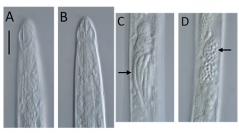

 European Journal of Taxonomy
748 (8) - Pages 138-154
European Journal of Taxonomy
748 (8) - Pages 138-154Recent work on the taxonomy of nematodes in Southwest Pacific Ocean trenches has led to the discovery of taxa which so far appear to be restricted to the oceans’ deepest environments. Here, Litinium gludi sp. nov. is described based on specimens obtained from a deep basin within the Kermadec Trench at 9540 m water depth. The new species differs from other species of the genus in having a conico-cylindrical tail, papillose labial sensilla, and heart- or leaf-shaped amphideal fovea. Both SSU and LSU phylogenetic analyses provide strong support for the placement of the new species within a clade containing both Thalassoalaimus and Litinum, and within Oxystomininae, which is consistent with the structure of the female reproductive system with only one posterior ovary in this subfamily. Our molecular analyses also indicate that the new species is most closely related to Thalassoalaimus despite lacking a caudal capsule, the main trait characterizing the latter genus, and despite being most morphologically similar to Litinium, particularly in the unusual shape of the amphideal fovea. However, given the changing definitions of the closely-related genera Thalassoalaimus and Litinium in recent years, available GenBank sequences may have been misidentified, which makes the interpretation of molecular phylogenetic analyses problematic. Given the current morphological definitions of Litinium and Thalassoalaimus, we choose to place the new species within Litinium, despite the apparently contradictory findings of molecular phylogenetic analyses. The placement of Cricohalalaimus in a clade with Thalassoalaimus and Litinium in both SSU and LSU analyses indicates that this genus should be placed within the Oxystomininae and not the Halalaiminae as in the current classification. This new proposed grouping is consistent with variation in the structure of the female reproductive system, a feature which appears more taxonomically informative than amphid shape for subfamily-level classification.